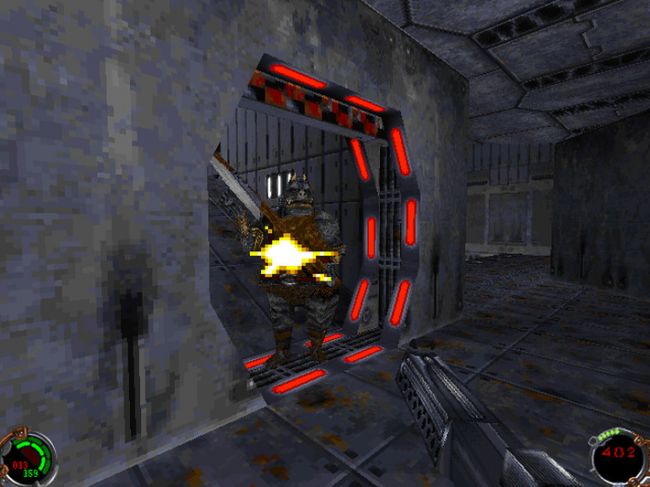As some who grew up during the ’90s, PC games are as synonymous with the Star Wars universe as the films are to me. X-Wing is the first PC game I ever owned—my dad had to buy an external disc drive just so we could play it—and on my birthday in 1998, I bought myself Jedi Knight: Dark Forces 2 and its Mysteries of the Sith expansion from Portsmouth’s long-gone Electronics Boutique to play on our old Pentium II PC. At the same time I bought Red Alert and its expansions in a giant box. It was a good birthday.
Jedi Knight was probably the biggest deal for me out of the classic Star Wars games that rolled out during the ’90s. The X-Wing/TIE Fighter series, Dark Forces, Rogue Squadron and eventually Episode I: Racer were also important games from that golden age of Lucasarts—and, if I’m being honest, I was a big fan of the roughshod shooter/minigame compilation Shadows of the Empire as well.
The novelty of Jedi Knight was taking Kyle Katarn from being the gun-wielding smuggler type of Dark Forces to a lightsaber-wielding warrior (or Sith lord, if you pushed the game in that direction). It was the first time Force powers had been well-realised in a 3D game: strangling enemies, taking their weapons, healing on the fly, using Force jump to reach higher locations. Lightsaber combat was a cornerstone of the game, but getting access to all of that felt like a real journey.

These are all ideas that would be refined further in Jedi Knight 2: Jedi Outcast, and even more so in Jedi Academy, games that would also significantly improve the quality of their lightsaber duels to make them more exciting during online play
The later Jedi Knight games arrived during a busier period for Star Wars, though, as the prequel trilogy rolled out into cinemas. The original Jedi Knight arrived in 1997, just under two years before Episode I: The Phantom Menace, and during a period where interest in the films was rekindled by the rerelease of the films in their Special Edition variants. There was a sense that Star Wars was about to become massive again, following a fallow period from the late ’80s to the mid ’90s broken by Timothy Zahn’s Thrawn trilogy, but it hadn’t quite happened yet. I remember this as a time where I’d read any Star Wars Expanded Universe novel I could get my hands on, and where the Kenner toys were starting to creep into my local supermarket.
Jedi Knight was like a gift during this time without new Star Wars movies. Not only did it show me Star Wars worlds, ships and characters I’d never seen before, but it did so with live-action, now rather hammy cutscenes. It was as close to getting a new Star Wars film as you could get at the time—well, that and the Rebel Assault games.
In the ’90s, at the age of 10, I thought these FMVs were cool as shit. We now live in an overwhelming noisy time for Star Wars content: I truly envy the kids who grew up watching The Clone Wars cartoon, or Rebels, or that newer one that looks like it’s aimed at toddlers. This was simply not the case in the time preceding The Phantom Menace: PC gaming was where you went for your Star Wars fix. Lucasarts had your back. I remember buying an issue of PC Gamer with a demo disc that featured samples of pretty much all the Star Wars games—that disc, ludicrously, is being sold on eBay for over £19 right now—and it’s still the only way I ever ended up sampling Yoda Stories.
Collectively, PC gaming covered almost every base of what a Star Wars fan could want at that time, from flight simulator to arcade shooter to world class FPS. With KOTOR and Galactic Battlegrounds/Empire At War, it’d eventually punch into the RPG and RTS genres too. Star Wars games are famously inconsistent, and there were always poorer titles in the mix, but I was always dazzled by the ways these games found such inventive angles based primarily on the material from those three original films. Jedi Knight was so formative that I doubt I’ll ever really stop thinking of Kyle Katarn as being part of Star Wars canon.
The reason I’m thinking about Jedi Knight now, then, is that Jedi: Fallen Order was revealed this past weekend, and the name alone will draw the connection for some older readers. I’m certain that Respawn’s Jedi game will be a totally different kind of experience, and it’ll probably be great in its own right, given the Titanfall developer’s previous work.
Star Wars games have tended to live their own weird vacuums—2008’s flawed but fun The Force Unleashed seemed to take no learnings from Jedi Knight, instead belonging to the lineage of QTE-heavy action games like God of War. And even though DICE’s Battlefront games are successors to Pandemic’s scrappier but more entertaining efforts (themselves a spin on Battlefield), they’re totally different experiences. No one’s made a successor to X-Wing, either, probably because there isn’t a belief that a big enough audience is waiting for one.
KOTOR aside, which lives on as the ageing MMO The Old Republic, Star Wars games don’t tend to get direct sequels years after the fact. They seem to exist more as generations of games—and these older Star Wars games felt specifically built for PC in a way that newer licensed entries likely never will be, given that they’re primarily meant to be enjoyed by a multi-platform audience.
That doesn’t mean they can’t be great games, of course, but those earlier games felt like they benefitted from having that singular focus on desktops. When Star Wars itself took a few years off, PC gaming picked up the slack—and that’s why those games still have a special place in my heart.
